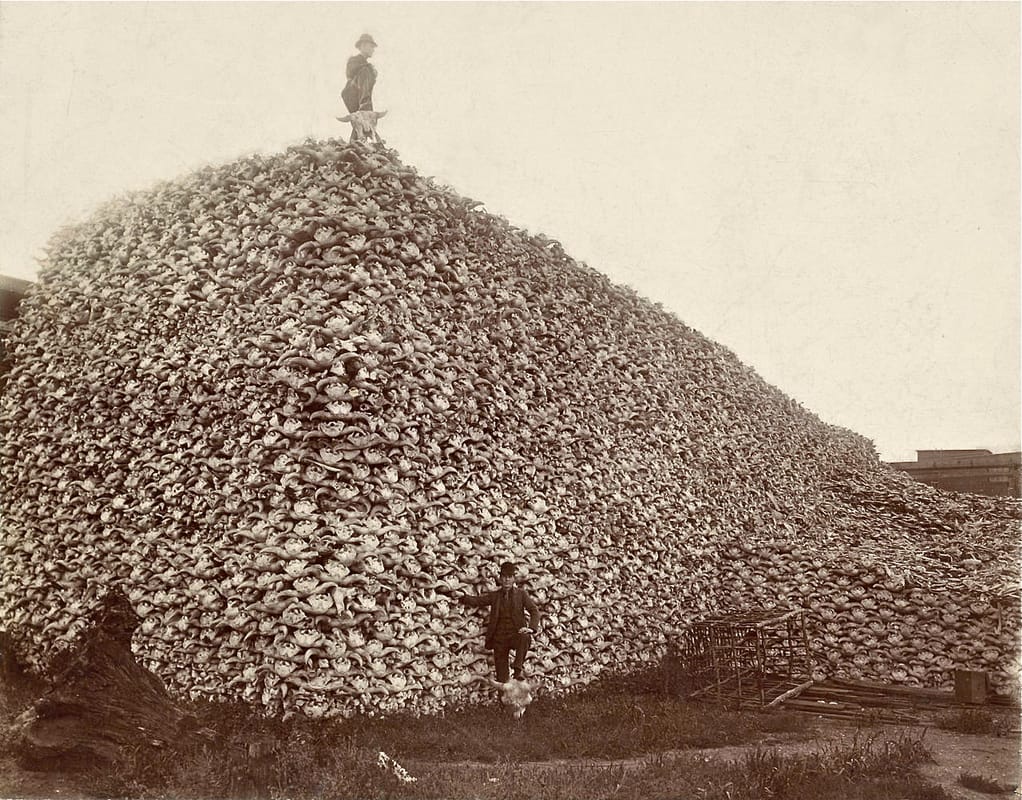Wovoka (Paiute): You ask me to plow the ground

_____________________________
Photo: Image from the mid-1870s of a pile of American bison skulls waiting to be ground for fertilizer. The massive slaughtering of buffalo in the 1800s worked to disconnect the animal from Native Americans. This had a substantial impact on Native people, physically as well as spiritually, emotionally, and mentally. As more settlers began coming to North America, conflicts arose between them and Native Americans. Settlers and the US government wanted to take over their land. Native Americans did not want to give it up. The Government saw the Native American's strong relationship with the buffalo. They figured that if they killed the buffalo, the Native Americans would surrender their lands and become a "civilized people". The military was ordered to kill the buffalo to deny Native Americans food. They believed they could do more to harm Native Americans faster by hiring buffalo hunters, than by using the army itself. The railroads were instrumental in the slaughter of the buffalo. First buffalo were killed for food during the building of the railroads. After they were built, buffalo were killed for safety reasons, because they were in the way and sometimes pushed the trains off the tracks. Traders and trappers killed buffalo just for the hides and left the rest of the animal to rot. Hides were sold for about $2.00 to $3.50 each. During one winter (1872-73), more than 1.5 million buffalo hides were sent on trains to the Eastern part of the United States to be sold! The bones were also sold for use in bone china, fertilizer, and in sugar processing. A ton of buffalo bones sold for about $8.00. Train companies offered trips out west to the settlers. Tourists were about to shoot as many buffalo as they could from the train window, only stopping when they ran out of bullets. Because of this, buffalo killing contests were held. During one contest, a person from Kansas set a buffalo killing record, killing 120 buffalo in 40 minutes. Another man named "Buffalo" Bill Cody was hired to kill buffalo. Within two years, he had killed 4,000 buffalo. Due to all the different reasons listed above, an estimated 31,000,000 buffalo were killed between the years of 1868 and 1881 with only 500 buffalo left by the year of 1885. By the end of the 19th Century, the Native American population was only 237,000, down from one million a century earlier.
________________________________________________
You ask me to plow the ground. Shall I take a knife and tear my mother's bosom? Then when I die she will not take me to her bosom to rest.
You ask me to dig for stones! Shall I dig under her skin for bones? Then when I die I cannot enter her body to be born again.
You ask me to cut grass and make hay and sell it and be rich like white men, but how dare I cut my mother's hair?
I want my people to stay with me here. All the dead men will come to life again. Their spirits will come to their bodies again. We must wait here in the homes of our fathers and be ready to meet them in the bosom of our mother.
(Wovoka, Paiute)
________________________________________________
Recommended reading:
'The Earth Shall Weep: A History of Native America'
by James Wilson (Author)
Purchase Book:
Amazon.com
Amazon.co.uk
Description:
Placing Native Americans centre-stage, and drawing not only on historical sources but also on ethnography, archaeology, Indian oral tradition, and research in contemporary Native American communities, this book sets out to recover their experience and make it accessible to a non-Indian audience. The text charts the course of the collision between indigenous cultures and European invaders, from the first English settlements on the Atlantic coast to the Wounded Knee massacre in 1890. At the same time, it explains how Europeans justified a process that reduced the Native American population from an estimated 7-10 million to less than 250,000 in four centuries. In his conclusion, the author shows how these same ideas have continued to underpin government policy towards native people in the 20th century and to distort popular perceptions of the "Indian".
'A wonderful new history of the Indians of the United States - thoroughly, and compellingly written.'
(Alvin Josephy, authour of 500 Nations)
_____________________________
________________________________________________


Leave a comment